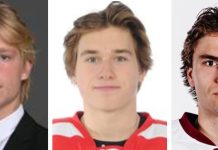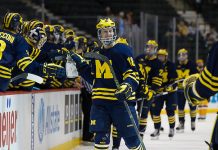I’ll be the first one to admit that the Hobey Watch is not necessarily always about a player who could win the Hobey Baker Award.
Honestly, I don’t think there’s anything wrong with that.
I know I make the Academy Award comparison often on this blog, but with the Oscars just a couple of days away it’s hard to avoid, and given the response I got with last week’s post on St. Lawrence’s Greg Carey, I think it’s appropriate to revisit.
On Sunday night, only one film will be named Best Picture (my pick is “Argo,” but I could wind up being completely wrong about that). However, eight other films will forever be referred to as Best Picture nominees, and while it’s not as good as the big prize, it’s a prestigious distinction (perhaps not so prestigious as when there were only five nominees, but that’s a whole other argument, and Kareem Abdul-Jabbar summed it up pretty nicely on Esquire.com, if you want to go check that out).
Taking it a step further, there’s a 9-year-old girl, Quvenzhane Wallis, who’s been nominated for Best Actress for her performance in “Beasts of the Southern Wild.” She’s not going to win. Another nominee, Emmanuelle Riva, became the oldest nominee in the history of the award when she got the nod for “Amour.” She’s not going to win, either. In both cases, being nominated is their “win,” and if that phrase sounds familiar to you, it’s probably because it’s used liberally around this time every year or possibly because I borrow it regularly to apply to possible Hobey finalists who have no real chance at capturing the award.
My usual examples of this are former Air Force forwards Jacques Lamoureux and Eric Ehn, but you can apply the phrase to any finalist from Atlantic Hockey (Reid Cashman, Simon Lambert, etc.), not to mention a Hobey candidate from a struggling program that has minimal chance at the NCAA tournament. I’m sure that if you asked, say, Michigan Tech alum Colin Murphy (2005), St. Lawrence’s T.J. Trevelyan (2006) or Colgate’s David McIntyre (2008), they’d tell you they were honored to be named Hobey finalists.
From a selfish perspective, my success at picking the finalists and the Hobey Hat Trick has been my measuring stick for as long as I’ve been following the Hobey Baker Award. Once you get to the Hat Trick, picking the winner is fairly easy more often than not (2005, 2007 and 2011 are notable exceptions). Picking a group of 10 finalists is much more challenging (I’ve never gotten all 10 right; nine is my career best), and picking the Hat Trick isn’t much easier (In 2010, I only got one of the three right).
How I do at picking finalists is how I measure myself against writers from other sites, which is probably a big part of why my “Hobey Watch” expands further than the winner of the actual award.
Honestly, if I were concerned only with the player that would win the Hobey Baker Award, I would have spent an awful lot of time writing about Johnny Gaudreau over the past month and a half. One of the national scoring leaders (when he hasn’t been on top of the board outright), playing for a team that’s headed for a high regional seed in the NCAA tournament, with an NCAA title already on his résumé, not to mention that World Juniors performance that we’ve discussed previously. Until his recent disappearance from the score sheet, there wasn’t much reason to doubt that the Boston College star will win the award because there was no real negative holding him down. That’s not to say that there aren’t other worthy candidates, but it’s seemed that there’s always some spot where Gaudreau has the edge.
Ryan Walters is having an outstanding season for UNO but if the Mavericks don’t make the NCAA tournament, it’s going to be really hard to see him winning the Hobey. Fan vote leader Corban Knight has been outstanding for North Dakota but even though he’s the program’s designated Hobey candidate, it’s Danny Kristo scoring the goals (and we know that “Hobey likes goals”).
Kristo … well, I’d like to know why the North Dakota coaching staff put up Knight instead, but the fact remains that Gaudreau is having the better season individually and BC is in a stronger position from a team perspective. Carey is the nation’s leading scorer and goal-scorer as of this writing but some might knock him for getting too many of his goals on the power play (10 of his 23), and, like Walters, he plays for a team that wouldn’t be in the NCAA tournament if the season ended today. Saints teammate Kyle Flanagan has the same problem, minus the goal-scoring. Brett Gensler has had outstanding numbers, but the strength of his competition isn’t the same playing in Atlantic Hockey.
For most of this season’s Hobey Watch, Gaudreau has had the statistical leg up on the competition, plus some other factor working in his favor. At the moment, however, that leg isn’t quite as high as it had been to this point, and it will be interesting to see how the race evolves from here.
And if, along the way, we talk about a few potential finalists who aren’t likely to go any further than the top 10, is that really such a bad thing?


